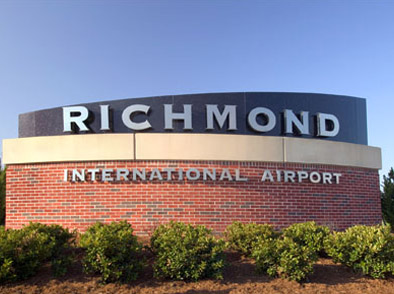If the nearly empty terminals weren’t enough of an indicator, the latest traffic counts released this week for Richmond International Airport show a clearer picture of the impact of coronavirus travel restrictions.
Passenger counts at RIC for March were down about 50 percent from the same month a year before, and down about 41 percent from February, showing the pandemic’s impacts were worse than previously thought.
RIC spokesman Troy Bell said the year-to-year difference for April is expected to be even more staggering when released in May, with nearly half of remaining flights – those that remained after airline service reductions – cancelled within 48 hours of departure.
“I’m certain that it’s more than 90 percent off what we would’ve reported the same period a year ago,” Bell said of this month’s passenger traffic. “The March numbers by comparison will look really good compared to what we will show for April.”
RIC counted 181,634 passengers in March, when restrictions on air travel began to take effect midmonth. That number is roughly half what the airport had in March 2019, when it tallied 366,592 passengers.
The drop is higher than what RIC saw in the weeks following 9/11, when airport passenger traffic dipped 42 percent in September 2001.
The March tally was 41 percent lower than February, when the airport recorded 310,913 passengers, an increase of 8 percent over the same month the year before. That was the last of 29 consecutive months in which passenger traffic at RIC surpassed records set the same months in previous years. It also marked the end of a seven-year run of consecutive monthly passenger traffic growth.
According to the report, the first 10 days of March saw no cancelled flights, whereas by the end of the month, 860 flights had been cancelled, 466 of those in the last week of March alone. The airport had averaged 137 cancellations in March since 2007, with the highest number of March cancellations coming in at 245 in that time.
Cargo traffic holding steady
While passenger traffic was halved, total cargo traffic in March held steady by comparison, coming in 5.4 percent below the same month last year but up 8 percent from February with more than 11 million pounds of freight and mail shipped through the airport.
Freight traffic in March was down 6 percent from last year but up nearly 9 percent from February. Mail was down 49 percent from last year and down 32 percent from February. Aircraft operations were down 11 percent from last year and down 3 percent from February.
The overall decrease in traffic meant a corresponding dip in operating revenues, which at $3.4 million in March were 21 percent below budget, according to financial reports. Year-to-date operating revenues reached $39.2 million, 1 percent above budget.
Operating expenses were 5 percent below budget at $2.2 million, with the airport cutting personnel expenses by $78,000 due to vacancies resulting from a hiring freeze. Parking expenses were $28,000 less than budget. Year-to-date operating expenses were likewise 5 percent below budget at $19.9 million.
Earlier this month, the Capital Region Airport Commission adopted an emergency resolution amending its bylaws and giving CEO Perry Miller additional powers to maintain airport operations. It also was awarded $18.8 million in federal CARES Act funding, part of a $309 million economic relief package for 47 airports in Virginia.
Bell said RIC has yet to receive the funding and is currently working through the related paperwork. The airport and its tenants are credited with creating nearly 16,000 jobs and $2.1 billion in regional economic activity annually.
“Passenger traffic right now, it’s not zero demand, but it’s really light demand, and I’d say that it’s essential travel,” Bell said. “Anybody that’s catching a flight right now feels that they must make that trip.”
If the nearly empty terminals weren’t enough of an indicator, the latest traffic counts released this week for Richmond International Airport show a clearer picture of the impact of coronavirus travel restrictions.
Passenger counts at RIC for March were down about 50 percent from the same month a year before, and down about 41 percent from February, showing the pandemic’s impacts were worse than previously thought.
RIC spokesman Troy Bell said the year-to-year difference for April is expected to be even more staggering when released in May, with nearly half of remaining flights – those that remained after airline service reductions – cancelled within 48 hours of departure.
“I’m certain that it’s more than 90 percent off what we would’ve reported the same period a year ago,” Bell said of this month’s passenger traffic. “The March numbers by comparison will look really good compared to what we will show for April.”
RIC counted 181,634 passengers in March, when restrictions on air travel began to take effect midmonth. That number is roughly half what the airport had in March 2019, when it tallied 366,592 passengers.
The drop is higher than what RIC saw in the weeks following 9/11, when airport passenger traffic dipped 42 percent in September 2001.
The March tally was 41 percent lower than February, when the airport recorded 310,913 passengers, an increase of 8 percent over the same month the year before. That was the last of 29 consecutive months in which passenger traffic at RIC surpassed records set the same months in previous years. It also marked the end of a seven-year run of consecutive monthly passenger traffic growth.
According to the report, the first 10 days of March saw no cancelled flights, whereas by the end of the month, 860 flights had been cancelled, 466 of those in the last week of March alone. The airport had averaged 137 cancellations in March since 2007, with the highest number of March cancellations coming in at 245 in that time.
Cargo traffic holding steady
While passenger traffic was halved, total cargo traffic in March held steady by comparison, coming in 5.4 percent below the same month last year but up 8 percent from February with more than 11 million pounds of freight and mail shipped through the airport.
Freight traffic in March was down 6 percent from last year but up nearly 9 percent from February. Mail was down 49 percent from last year and down 32 percent from February. Aircraft operations were down 11 percent from last year and down 3 percent from February.
The overall decrease in traffic meant a corresponding dip in operating revenues, which at $3.4 million in March were 21 percent below budget, according to financial reports. Year-to-date operating revenues reached $39.2 million, 1 percent above budget.
Operating expenses were 5 percent below budget at $2.2 million, with the airport cutting personnel expenses by $78,000 due to vacancies resulting from a hiring freeze. Parking expenses were $28,000 less than budget. Year-to-date operating expenses were likewise 5 percent below budget at $19.9 million.
Earlier this month, the Capital Region Airport Commission adopted an emergency resolution amending its bylaws and giving CEO Perry Miller additional powers to maintain airport operations. It also was awarded $18.8 million in federal CARES Act funding, part of a $309 million economic relief package for 47 airports in Virginia.
Bell said RIC has yet to receive the funding and is currently working through the related paperwork. The airport and its tenants are credited with creating nearly 16,000 jobs and $2.1 billion in regional economic activity annually.
“Passenger traffic right now, it’s not zero demand, but it’s really light demand, and I’d say that it’s essential travel,” Bell said. “Anybody that’s catching a flight right now feels that they must make that trip.”




